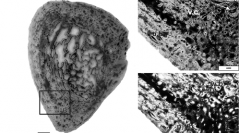

 Comptes Rendus Palevol
15 (1-2) - Pages 103-114
Comptes Rendus Palevol
15 (1-2) - Pages 103-114The histological framework of thirteen Early Permian tetrapod long bones from a single locality, the Briar Creek Bonebed in Archer County, Texas, USA, is described from a series of transverse sections through the midshafts. The bones were morphologically categorized and belong to one of three taxa: Eryops, Archeria, and Diadectes. However, five histotypes are recognized. The first category includes the juvenile bone. The second histotype is characterized by the presence of radial vascular canals. The third histotype is characterized by the numerous longitudinal canals arranged in regular rows. In the fourth histotype, there is strong remodeling in the deep part of the cortex, creating a distinct border with the external layer of lamellar bone. In the fifth histotype, the deep part of the cortex is progressively remodeled towards osteoporosis with distinct layers of large circumferentially arranged erosion cavities. For femora and humeri, histotypes match morphology. Histotype II is characteristic for Diadectes propodials, histotype III is characteristic for Eryops propodials, and histotype IV is characteristic for Archeria propodials. A discrepancy between morphology and histology is observed in the ulnae, fibula and radius. This discrepancy may be explained by interspecific or intraspecific variability.
Early Permian, Briar Creek Bonebed, Histology, Long bones, Eryops, Archeria, Diadectes